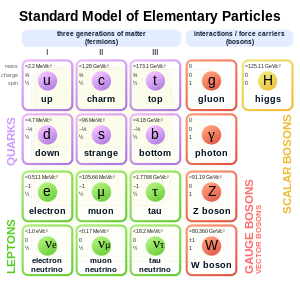You may recall a previous post about Hydrogen in stars. To wit, this happens:
| 1 1H | + | 1 1H | → | 2 1D | + | e+ | + | ν e | + | 0.42 MeV |
Which translates roughly as two Hydrogen atoms becoming a Deuterium atom, an electron, a neutrino, and some excess energy.
There is a general principle in chemical/particle interactions of conservation. Certain characteristics - such as spin, electrical charge, energy, momentum - must carry over from the beginning to the end. In the early 1900's, this requirement was being defied in beta decay, which also produces a proton and an electron (or positron), resulting in what appeared to be a missing amount of energy. Wolfgang Pauli first suggested the idea of a small (relative to other particles), electrically neutral particle, and Enrico Fermi used the idea, assuming the neutrino's existence and positing a successful model of the interaction.
Ok, lets fast forward to the 1940's. Neutrinos (or rather, the result of other particles interacting with neutrinos) are detected in a very clever experiment.
Now let's fast forward again to the 60's, because that's where the important things happens.
As I said earlier, neutrinos are produced in some of the reactions inside stars. Something you should know about neutrinos; as they are electrically neutral, they effectively do not interact with electromagnetic fields (there is a very tiny magnetic moment, but irrelevant for the likes of us and our blogs), meaning they can pass though matter quite unphased. About a million billion neutrinos from the sun pass through you each second, with nary a strain on your molecular make-up (lucky you).
So! The first of several neutrino particle detectors was built in the late 1960's. It was placed nearly a mile down in a gold mine in South Dakota. It was placed so deep to protect it from all the other particles and rays (mostly from the cosmos) that could interfere with the experiment.
A 100,000 gallon tank was filled with perchloroethylene, which was predicted to, on occasion, interact with neutrinos, changing a chlorine atom to a radioactive argon atom. Of all the neutrinos to pass through this large tank (much larger than your own surface, with your million billion neutrinos per second), it was predicted that about once a day, a single neutrino will interact with a single chlorine.
Which I hope gives you a perspective on just how ridiculously delicate such a detection is.
What happened was not a reaction every day, but a reaction about every three days. A mere third of the expected neutrino reactions were occurring. They checked their predictions, their equipment, their calculations, their results; they could not find any issue with the experiment itself. Eventually, other detectors were built and verified the lack of expected neutrinos.
Neutrinos were, in the Standard Model of the time, assumed to be massless. But it was determined that if they have any mass, even the slightest bit, possibilities begin to emerge.
With mass, neutrinos would, for reasons we won't get into here, be capable of oscillating between flavors - a quantum number assigned to particles. The idea, first proposed by Bruno Pontecorvo in 1957, that neutrinos may actually exist as a superposition of three possible states, oscillating between possibilities. These oscillations for solar neutrinos would take place on their way out of the sun, interacting with the chaotic matter.
Now we have hope. If the detectors were incapable of tasting every flavor, then it stands to reason that not every neutrino would be noticed.
It wasn't until 1984 that a proper detector was proposed by Herb Chen of the University of California at Irvine. Heavy water (which has Deuterium atoms instead of Hydrogen) is an ideal candidate for interacting with all three neutrinos. The Sudbury Neutrino Observatory, over a mile under the surface, was turned on in 1999.
In 1998 the Super-Kamiokande in Japan, using pure water and originally built to determine if proton decay exists in the universe, determined the existence of neutrino oscillation (from any neutrino source).
And finally, in 2001, more than 40 years after it was proposed, Sudbury had undeniable evidence that the solar neutrinos oscillate, and verified the originally predicted amount of neutrinos being produced.
How beautiful is that!? A question spans continents and decades; testaments to our ingenuity are brilliantly engineered based on the theoretical propositions of people who weren't even alive anymore. And they were right!
And the body of knowledge keeps growing.
(Super-Kamiokande)
(The current Standard Model of Elementary Particles)


No comments:
Post a Comment